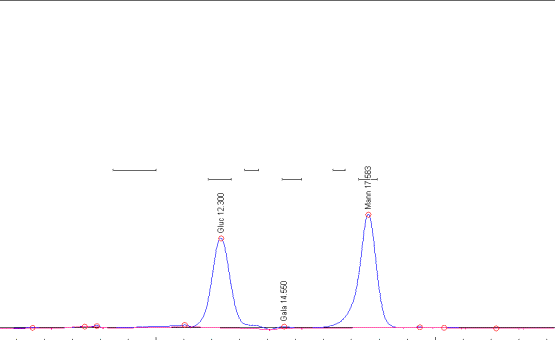
Three species of Lycopersicon esculentum differ in sugar and protein content after sugar, HPLC, protein and pigment tests
By
Steven Brooks
Marc Brzozowski
Jason Harner
Christopher Stuart
Abstract
The overall goal of our investigation was to identify carbohydrate, protein, and pigment differences between greenhouse tomatoes, UglyRipe tomatoes, and organic tomatoes. The tests used to determine carbohydrate composition were Benedict’s test, Barfoed’s test, Selivanoff’s test, Bial’s test, and the Iodine test. The tests provided no distinction between tomatoes. The Bradford Assay was used to determine the concentration of protein in the tomatoes. We found the highest concentration in UglyRipe tomatoes with .1490 µg/µL, organic tomatoes had .0546 µg/µL, and greenhouse tomatoes had .0657 µg/µL. Paper chromatography was used to determine the types of pigments in the tomatoes. We noticed lighter coloration in the organic tomatoes which correlates to higher levels of tomatine, so we predicted that greenhouse and UglyRipe tomatoes would have similar pigments and that organic tomatoes would contain more chlorophyll/tomatine, however our tests came back inconclusive. High Performance Liquid Chromatography (HPLC) was used to test quantitatively for glucose, cellobiose, xylose, arabinose, galactose, and mannose. Organic tomatoes were found to have the greatest amount of carbohydrates (10.2509 g/L of glucose, 0.5764 g/L of galactose, and 10.6502 g/L of mannose), followed by greenhouse (9.3474 g/L of glucose and 9.0035 g/L of mannose) and then UglyRipe tomatoes (6.6188 g/L of glucose, 0.4952 g/L of xylose, 8.7843 g/L of mannose). Due to previous research showing lower protein concentration in organic foods, it was predicted that greenhouse and UglyRipe tomatoes would have a higher protein concentration than organic tomatoes.

Figure 9. The sugar contents of the organic tomato. This data was collected from the organic tomato, which was run through the HPLC machine. The organic tomato contained glucose, mannose, and galactose.
Discussion
Our hypothesis was that greenhouse tomatoes, UglyRipe tomatoes, and organic tomatoes differ in their carbohydrate, protein, and pigment make-up. We predicted from taste testing that UglyRipe tomatoes would have the most carbohydrates (both quantitatively and qualitatively) because their taste was the sweetest, which could be caused by a greater amount of glucose (Freeman, 2002). We further predicted that greenhouse tomatoes would be next, and then lastly organic tomatoes, based on taste. We predicted that the greenhouse and UglyRipe tomatoes would have higher protein content than the organic tomatoes due to previous research showing some organic foods contain less protein (Woese et al., 1997). We also predicted that the pigment make-up would be similar in greenhouse and UglyRipe tomatoes but that organic tomatoes would have more types of chlorophyll and tomatine because they are lighter (Friedman, 2004).
Earlier studies have documented the presence of glucose, maltose, xylose, and fructose in tomatoes (Lugtenberg et al., 1999). The Bial’s test produced a brown color change in all of the three tomatoes for each of the five trials. The presence of a brown color in the Bial’s test indicates that there is a hexose (or larger) furanose present in the sample (Krha et al., 2005). The Bial’s test makes sense because it indicates the presence of a furanose ring and glucose, maltose, xylose, and fructose each contain a furanose ring (Krha et al., 2005).
The Benedict’s test yielded a precipitate and the color of the liquid changed from the initial blue to an orange-red color on all five trials of each of the three tomatoes. This indicated the presence of reducing sugars, specifically a free or potentially free aldehyde or ketone group (Krha et al., 2005). Similarly, the Barfoed’s test yielded an orange-red precipitate for all of the tomatoes in each of the five trials as well. This indicates that reducing sugars, specifically, monosaccharides are present. All monosaccharides are reducing sugars when they are in the straight chain form (Frydrych et al., 2001). All four of the previously highlighted sugars in tomatoes are reducing sugars. Glucose, xylose, and fructose are monosaccharides and maltose is a disaccharide identified as a reducing sugar because it is made up of two glucose monomers (Krha et al., 2005). These are reducing sugars because there is a free aldehyde or ketone group (Krha et al., 2005). Both Barfoed’s and Benedicts test hold true because there are reducing sugars and monosaccharides present in the tomatoes in the form of glucose, xylose, fructose, and maltose (Krha et al., 2005).
Selivanoff’s test produced a red substance in roughly a minute for all five trials of the UglyRipe tomatoes. A red substance produced at roughly one minute indicates the prescence of a disaccharide ketose (Krha et al., 2005). In all five trials of the greenhouse and organic tomatoes, the red substance appeared at 40 seconds. This color change at less than a minute indicates the presence of a monosacchride ketose (Krha et al., 2005). The formation of a red material in more than a minutes’ time would indicate the presence of an aldose (Krha et al., 2005). Glucose, maltose, xylose, and fructose are known to be found in tomatoes (Lugtenberg et al., 1999). Glucose is an aldose. Xylose and fructose are both ketoses. This is relevant because it is possible that the Selivanoff’s test yielded a red substance in about one minute not because of the sole presence of a disaccharide ketose, but because the tomato sample that we tested had multiple sugars in it. The sugar glucose is an aldose, the sugar maltose is made up of two glucose monomers, the sugar xylose is a ketose, and the sugar fructose is a ketose (Krha et al., 2005). The production of a red precipitate in about a minute was a compromise of the two different results dictated by the presence an aldose and the presence of a ketose (Krha et al., 2005).
The Iodine test was negative. A blue-black color will indicate the presence of starch (Krha et al., 2005). In each of the five trials for all three of the tomatoes, there was no color change that occurred. The positive control (starch) turned the blue-black color so the procedure worked correctly. The data shows that there is no starch in each of the three types of tomatoes. However, there is still human error to consider. The tomatoes were centrifuged earlier in the lab and the tomato sample was taken from the supernatant liquid at the top of the vial. There could have been starch present in the solid matter left in the bottom of the vial after centrifugation.
In each of the five sugar tests, a negative control was used to make sure that each test was not giving positive results when they were not present. Each time, the negative control that was used was water (H 2O). Water was chosen as a negative control for the sugar tests because it is not a reducing sugar, it does not have a ketose or aldose group, it does not have a furanose ring, and it doesn’t have any starch present in it.
We used the Bradford assay to test for the protein concentration in our tomatoes. We found that greenhouse tomatoes had a protein concentration of 0.0657 mg/ ml, the organic tomatoes had a protein concentration of 0.0546 mg/ ml, and UglyRipe tomatoes had a protein concentration of 0.1490 mg/ ml. This showed that UglyRipe tomatoes had the highest protein concentration by over double compared to the other tomatoes. This went against our prediction, which was based on previous research, that organic foods sometimes contain a higher protein concentration than their conventionally grown counterpart (Woese et al., 1997). A reason that the protein concentrations seem very low may be due to the fact that we centrifuged the samples and used the supernatant liquid to do our test. The protein may have been located primarily in the solid matter, which would throw off our concentrations. However, our data is still reliable since all three samples were centrifuged and the proportions of protein concentration would remain the same throughout the samples.
There was a noticeable difference in color between our different types of tomatoes. The organic tomatoes were much lighter than both the greenhouse and UglyRipe tomatoes, which were similar in color. For this reason we predicted that organic tomatoes contained a greater variety of types of chlorophyll and tomatine. A lighter pigment make-up in tomatoes has been found to be caused by a greater amount of chlorophyll and tomatine (Friedman, 2004). We may have been mistaken to conclude from our observation that pigment make-up would differ between the three types of tomatoes. It may have only been caused by different degrees of ripeness. We ran a paper chromatography test to identify the pigments in each type of tomato. Our first set of trials failed to show any result; all of the chromatography strips were blank. The most likely cause of this was that our samples were too old and the pigments had started degrading. Our second set of trials also failed to show any results; there were only blue marks on the chromatography strips. The cause of this was that the petroleum ether that was used was contaminated. According to previous research, the paper chromatography should have shown that carotene was present in all three types of tomatoes (Brandenburg et al., 2002). This would lead us to believe that our hypothesis was incorrect in assuming that the pigment make-up of the three types of tomatoes would differ. Therefore, different ways of growing tomatoes has no effect on their pigment make-up.
We predicted that our qualitative carbohydrate tests would only dictate that the same sugars are found in each tomato. We ran an HPLC test on our three tomatoes to determine quantitatively the amount of each type of sugar present in each tomato. The HPLC test did not support our prediction that the UglyRipe tomato had a higher quantitative amount of sugar present in it. A maximum of six sugars could be observed in each tomato using the HPLC. The six sugars were glucose, galactose, cellobiose, xylose, arabinose, and mannose. A possible source of error in the HPLC test was the human contamination of the pureed tomato samples. An additional source of error was the time the tomato samples set out at room temperature in preparation for each test.
In the end our initial prediction that there is more sugar, both qualitatively and quantitatively, in greenhouse and UglyRipe tomatoes was incorrect. The HPLC test showed us that quantitatively there is more sugar in organic tomatoes. This was a surprise to us because our initial taste test led us to believe that there is more sugar in the greenhouse and UglyRipe tomatoes. Also, our qualitative sugar tests showed no great variation in sugars present in the three types of tomatoes. Our research leaves us with a few questions. For example: Do these results correspond to all organically grown food, or is it just specific to tomatoes? This question and others can only be answered by more research on all three types of tomatoes and other types of organic foods. It is the fact that there really isn’t much research on UglyRipe tomatoes that gave us the idea to do our own research on them. We would be interested in continuing this research more in depth in the future.
![]()
